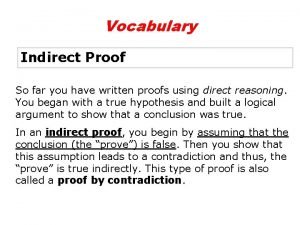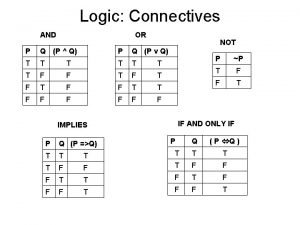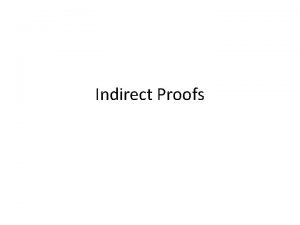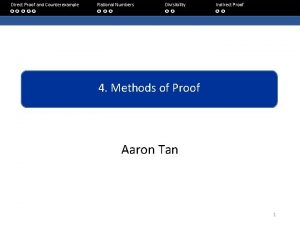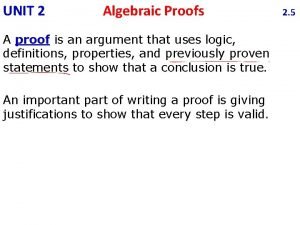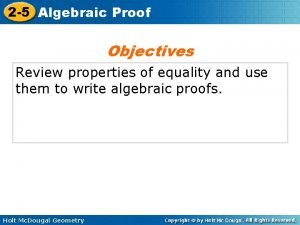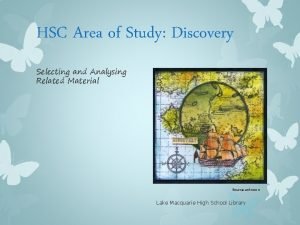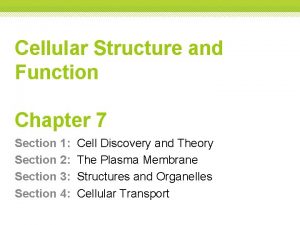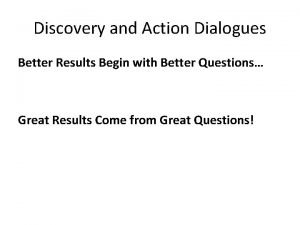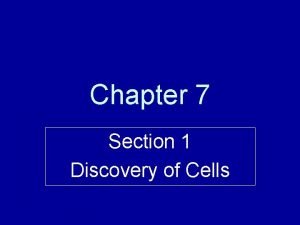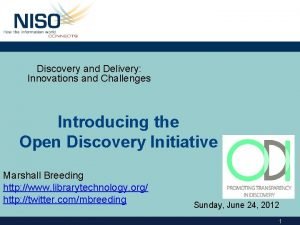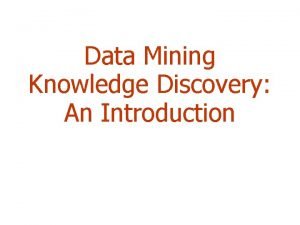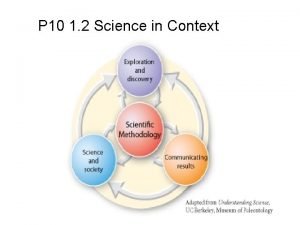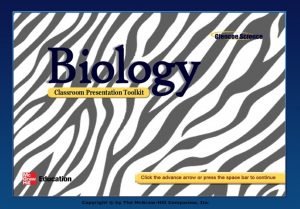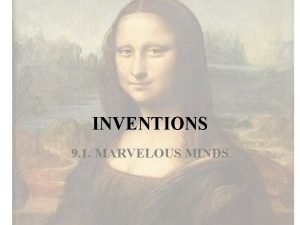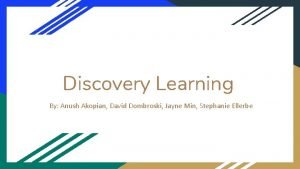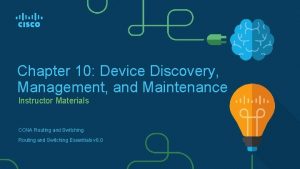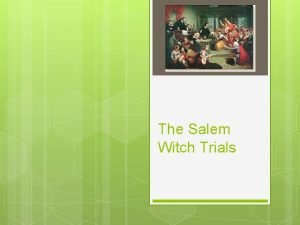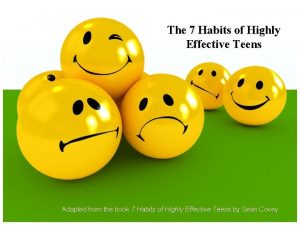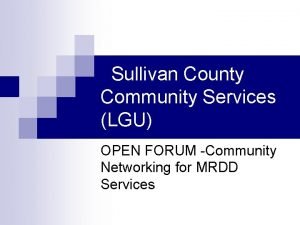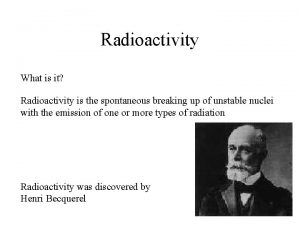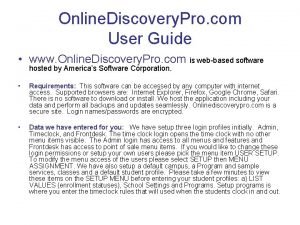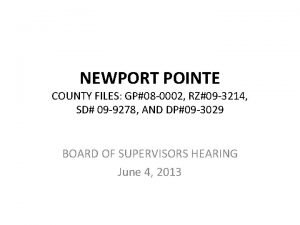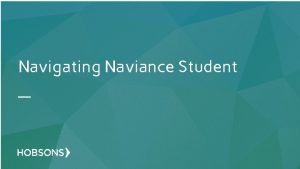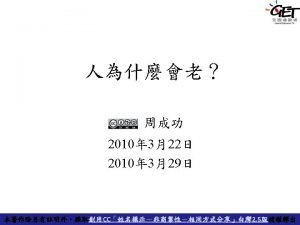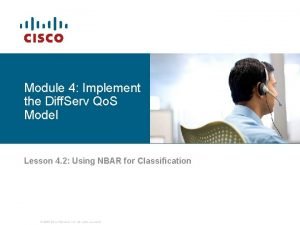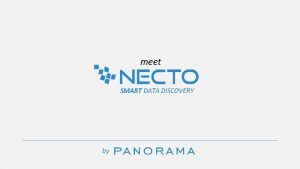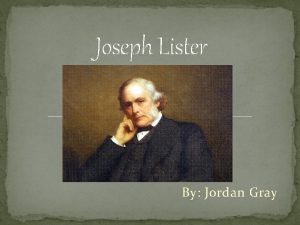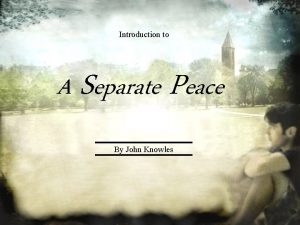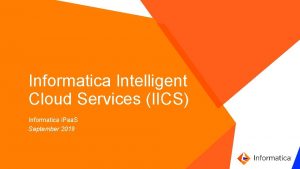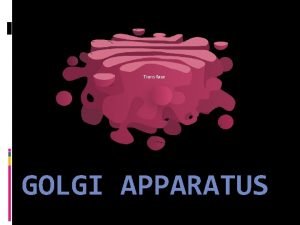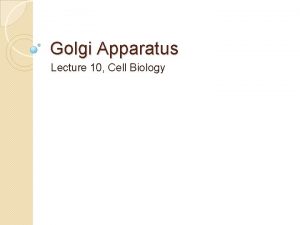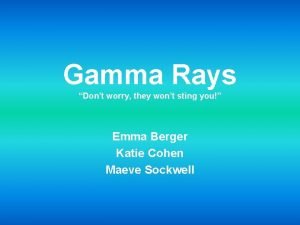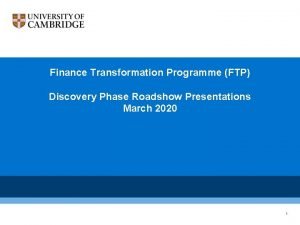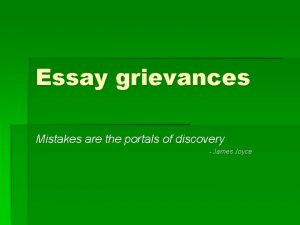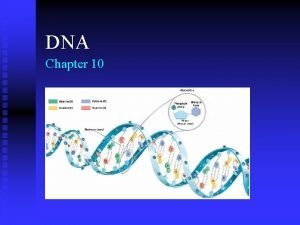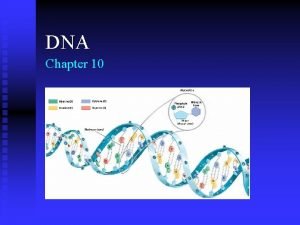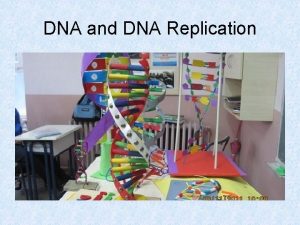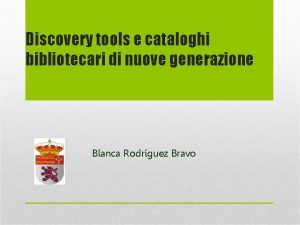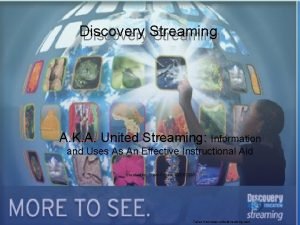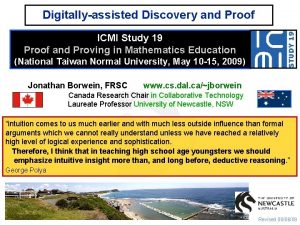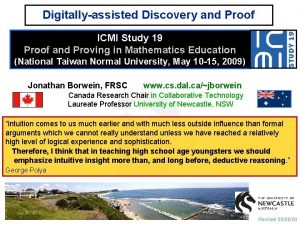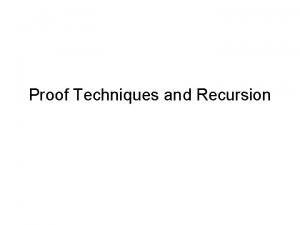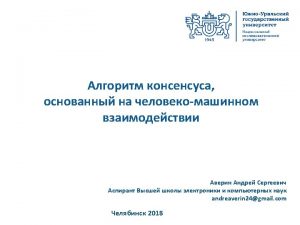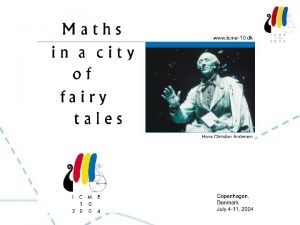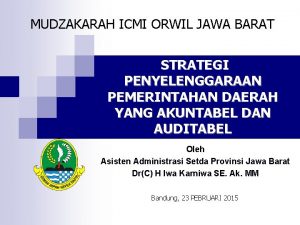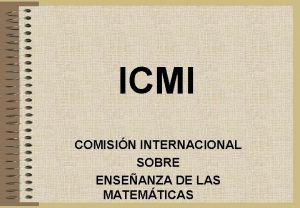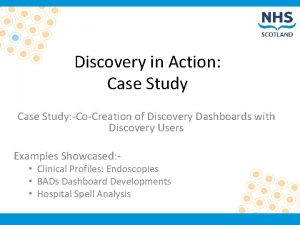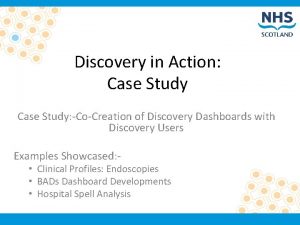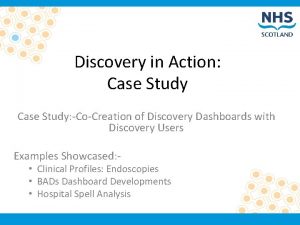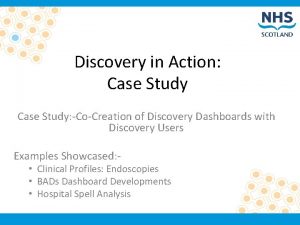Digitallyassisted Discovery and Proof ICMI Study 19 Proof




















































- Slides: 52

Digitally-assisted Discovery and Proof ICMI Study 19 Proof and Proving in Mathematics Education (National Taiwan Normal University, May 10 -15, 2009) Jonathan Borwein, FRSC www. cs. dal. ca/~jborwein Canada Research Chair in Collaborative Technology Laureate Professor University of Newcastle, NSW “intuition comes to us much earlier and with much less outside influence than formal arguments which we cannot really understand unless we have reached a relatively high level of logical experience and sophistication. Therefore, I think that in teaching high school age youngsters we should emphasize intuitive insight more than, and long before, deductive reasoning. ” George Polya Revised 30/08/2008 Revised 08/06/09

New ICMI Website "Mathematical proofs like diamonds should be hard and clear, and will be touched with nothing but strict reasoning. " - John Locke "Keynes distrusted intellectual rigour of the Ricardian type as likely to get in the way of original thinking and saw that it was not uncommon to hit on a valid conclusion before finding a logical path to it. " - Sir Alec Cairncross, 1996

ABSTRACT Jonathan M. Borwein Dalhousie and Director Newcastle Centre for Computer Assisted Research Mathematics and its Applications (CARMA) I will argue that the mathematical community (appropriately defined) is facing a great challenge to re-evaluate the role of proof in light of the power of current computer systems, of modern mathematical computing packages and of the growing capacity to data-mine on the internet. With great challenges come great opportunities. I intend to illustrate the current challenges and opportunities for the learning and doing of mathematics. "The object of mathematical rigor is to sanction and legitimize the conquests of intuition, and there was never any other object for it. " – Jacques Hadamard

“The Crucible”

OUTLINE · Working Definitions of: § Discovery § Proof § Digital-Assistance · Five (Tertiary) Core Examples: § § § Number Theory: What is that number? Calculus: Why Pi is really not 22/7. Algebra: Making abstract algebra concrete. Physics: A more advanced foray into mathematical physics. Geometry: dynamics I can visualize but have no proof of. · Making Some Tacit Conclusions Explicit · Additional Examples (as time permits) § Integer Relation Algorithms § Wilf-Zeilberger Summation It won’t!

WHAT is a DISCOVERY? “discovering a truth has three components. First, there is the independence requirement, which is just that one comes to believe the proposition concerned by one’s own lights, without reading it or being told. Secondly, there is the requirement that one comes to believe it in a reliable way. Finally, there is the requirement that one’s coming to believe it involves no violation of one’s epistemic state. … In short , discovering a truth is coming to believe it in an independent, reliable, and rational way. ” Marcus Giaquinto, Visual Thinking in Mathematics. An Epistemological Study, p. 50, OUP 2007 “All truths are easy to understand once they are discovered; the point is to discover them. ” – Galileo Galilei

Galileo was not alone in this view “I will send you the proofs of theorems in this book. Since, as I said, I know that you are diligent, an excellent teacher of philosophy, and greatly interested in any mathematical investigations that may come your way, I thought it might be appropriate to write down and set forth for you in this same book a certain special method, by means of which you will be enabled to recognize certain mathematical questions with the aid of mechanics. I am convinced that this is no less useful for finding proofs of these same theorems. For some things, which first became clear to me by the mechanical method, were afterwards proved geometrically, because their investigation by the said method does not furnish an actual demonstration. For it is easier to supply the proof when we have previously acquired, by the method, some knowledge of the questions than it is to find it without any previous knowledge. ” Archimedes to Eratosthenes in introduction to The Method in Mario Livio, Is God a Mathematician? Simon and Schuster, 2009

The Archimedes Palimpsest · 1906 10 th-century palimpsest was discovered in Constantinople (Codex C). 1998 bought at auction for $2 million 1998 -2008 “reconstructed” · contained works of Archimedes that, sometime before April 14 th 1229, were partially erased, cut up, and overwritten by religious text · after 1929 painted over with gold icons and left in a wet bucket in a garden. It included bits of 7 texts such as On Floating Bodies and of the Method of Mechanical Theorems, thought lost · Archimedes used knowledge of levers and centres of gravity to envision ways of balancing geometric figures against one another which allowed him to compare their areas or volumes. He then used rigorous geometric argument to prove Method discoveries: ". . . certain things first became clear to me by a mechanical method, although they had to be proved by geometry afterwards because their investigation by the said method did not furnish an actual proof. But it is of course easier, when we have previously acquired, by the method, some knowledge of the questions, to supply the proof than it is to find it without any previous knowledge. " (The Method) · Used Moore-Penrose inverses to reconstruct text and extract forgeries. See 2006 Google lecture at http: //video. google. com/videoplay? docid=8211813884612792878 Creative commons: http: //www. archimedespalimpsest. net

WHAT is a PROOF? “PROOF, n. a sequence of statements, each of which is either validly derived from those preceding it or is an axiom or assumption, and the final member of which, the conclusion , is the statement of which the truth is thereby established. A direct proof proceeds linearly from premises to conclusion; an indirect proof (also called reductio ad absurdum) assumes the falsehood of the desired conclusion and shows that to be impossible. See also induction, deduction, valid. ” Borowski & JB, Collins Dictionary of Mathematics INDUCTION , n. 3. ( Logic) a process of reasoning in which a general conclusion is drawn from a set of particular premises, often drawn from experience or from experimental evidence. The conclusion goes beyond the information contained in the premises and does not follow necessarily from them. Thus an inductive argument may be highly probable yet lead to a false conclusion; for example, large numbers of sightings at widely varying times and places provide very strong grounds for the falsehood that all swans are white. “No. I have been teaching it all my life, and I do not want to have my ideas upset. ” - Isaac Todhunter (1820 - 1884) recording Maxwell’s response when asked whether he would like to see an experimental demonstration of conical refraction.

Decide for yourself

WHAT is DIGITAL ASSISTANCE? · Use of Modern Mathematical Computer Packages § Symbolic, Numeric, Geometric, Graphical, … · Use of More Specialist Packages or General Purpose Languages § Fortran, C++, CPLEX, GAP, PARI, MAGMA, … · Use of Web Applications § Sloane’s Encyclopedia, Inverse Symbolic Calculator, Fractal Explorer, Euclid in Java, Weeks’ Topological Games, … · Use of Web Databases § Google, Math. Sci. Net, Ar. Xiv, JSTOR, Wikipedia, Math. World, Planet Math, DLMF, Mac. Tutor, Amazon, …, Wolfram Alpha (? ? ) · All entail data-mining [“exploratory experimentation” and “widening technology” as in pharmacology, astrophysics, biotech… (Franklin)] § § Clearly the boundaries are blurred and getting blurrier Judgments of a given source’s quality vary and are context dependent “Knowing things is very 20 th century. You just need to be able to find things. ” - Danny Hillis - on how Google has already changed how we think in Achenblog, July 1 2008 Google - changing cognitive styles

Changing User Experience and Expectations What is attention? (Stroop test, 1935) 1. Say the color represented by the word. 2. Say the color represented by the font color. High (young) multitaskers perform #2 very easily. They are great at suppressing information. http: //www. snre. umich. edu/eplab/demos/st 0/stroop_program/stroopgraphicnon shockwave. gif Acknowledgements: Cliff Nass, CHIME lab, Stanford (interference and twitter? )

JMB’s Math Portal

Experimental Mathodology 1. Gaining insight and intuition Science News 2004 2. Discovering new relationships “Computers are 3. useless, Visualizing math principles they can only give answers. ” 4. Testing and especially falsifying conjectures Pablo Picasso Experimental Mathodology 5. Exploring a possible result to see if it merits formal proof 6. Suggesting approaches formal proof 7. Computing replacing lengthy hand derivations 8. Confirming analytically derived results Comparing –y 2 ln(y) (red) to y-y 2 and y 2 -y 4

Example 1. What is that number? (1995 -- 2008) In I 995 or so Andrew Granville emailed me the number and challenged me to identify it (our inverse calculator was new in those days). Changing representations, I asked for its continued fraction? It was I reached for a good book on continued fractions and found the answer where I 0 and I 1 are Bessel functions of the first kind. (Actually I knew that all arithmetic continued fractions arise in such fashion). In 2009 there at least three other strategies: • Given (1), type “arithmetic progression”, “continued fraction” into Google • Type 1, 4, 3, 3, 1, 2, 7, 4, 2 into Sloane’s Encyclopaedia of Integer Sequences I illustrate the results on the next two slides:

“arithmetic progression”, “continued fraction” In Google on October 15 2008 the first three hits were Continued Fraction Constant -- from Wolfram Math. World - 3 visits - 14/09/07 Perron (1954 -57) discusses continued fractions having terms even more general than the arithmetic progression and relates them to various special functions. . mathworld. wolfram. com/Continued. Fraction. Constant. html - 31 k HAKMEM -- CONTINUED FRACTIONS -- DRAFT, NOT YET PROOFED The value of a continued fraction with partial quotients increasing in arithmetic progression is I (2/D) A/D [A+D, A+2 D, A+3 D, . . www. inwap. com/pdp 10/hbaker/hakmem/cf. html - 25 k - On simple continued fractions with partial quotients in arithmetic. . . 0. This means that the sequence of partial quotients of the continued fractions under. investigation consists of finitely many arithmetic progressions (with. . . www. springerlink. com/index/C 0 VXH 713662 G 1815. pdf - by P Bundschuh – 1998 Moreover the Math. World entry includes

Example 1: In the Integer Sequence Data Base The Inverse Calculator returns Best guess: Bes. I(0, 2)/Bes. I(1, 2) • We show the ISC on another number next • Most functionality of ISC is built into “identify” in Maple "The price of metaphor is eternal vigilance. ” - Arturo Rosenblueth & Norbert Wiener quoted by R. C. Leowontin, Science p. 1264, Feb 16, 2001 [Human Genome Issue].

The ISC in Action Input of • ISC+ runs on Glooscap • Less lookup & more algorithms than 1995

Example 2. Pi and 22/7 (Year dot through 2008) The following integral was made popular in a 1971 Eureka article • Set on a 1960 Sydney honours final it perhaps originated in 1941 with the author of the 1971 article [Dalzeil did not reference himself!] Why trust the evaluation? Well Maple and Mathematica both ‘do it’ • A better answer is to ask Maple for • It will return and now differentiation and the Fundamental theorem of calculus proves the result. • Not a conventional proof but a totally rigorous one. (An ‘instrumental use’ of the computer)

Example 3. Multivariate Zeta Values In April 1993, Enrico Au-Yeung, then an undergraduate at the University of Waterloo, brought to my attention the result 17/360=0. 047222. . I was very skeptical, but Parseval’s identity computations affirmed this to high precision. This is a effectively a special case of the following class: where sj are integers and j= signum sj. These can be rapidly computed as implemented at www. cecm. sfu. ca/projects/ezface+. In the past 20 years they have become of more and more interest in number theory, combinatorics, knot theory and mathematical physics. A marvellous example is Zagier’s conjecture (found experimentally and now proven).

Example 3. Related Matrices (1993 -2008) In the course of studying such multiple zeta values we needed to obtain the closed form partial fraction decomposition for This was known to Euler but is easily discovered in Maple. We needed also to show that M=A+B-C was invertible where the n by n matrices A, B, C respectively had entries Thus, A and C are triangular and B is full. After messing with many cases I thought to ask for M’s minimal polynomial > linalg[minpoly](M(12), t); > linalg[minpoly](B(20), t); > linalg[minpoly](A(20), t); > linalg[minpoly](C(20), t);

Example 3. The Matrices Conquered Once this was discovered proving that for all n >2 is a nice combinatorial exercise (by hand or computer). Clearly then and the formula is again a fun exercise in formal algebra; as is confirming that we have discovered an amusing representation of the symmetric group • characteristic and minimal polynomials --- which were rather abstract for me as a student --- now become members of a rapidly growing box of symbolic tools, as do many matrix decompositions, etc … • a typical matrix has a full degree minimal polynomial “Why should I refuse a good dinner simply because I don't understand the digestive processes involved? ” - Oliver Heaviside (1850 -1925)

Example 4. Numerical Integration (2006 -2008) The following integrals arise independently in mathematical physics in Quantum Field Theory and in Ising Theory: We first showed that this can be transformed to a 1 -D integral: where K 0 is a modified Bessel function. We then computed 400 -digit numerical values, from which we found these results (now proven): The limit discovery showed the Bessel function representation to be fundamental.

Example 4: Identifying the Limit Using the Inverse Symbolic Calculator (2. 0) We discovered the limit result as follow. We first calculated: We then used the Inverse Symbolic Calculator, the online numerical constant recognition facility, available at: http: //ddrive. cs. dal. ca/~isc/portal Output: Mixed constants, 2 with elementary transforms. 6304735033743867 = sr(2)^2/exp(gamma)^2 In other words References. Bailey, Borwein and Crandall, “Integrals of the Ising Class, " J. Phys. A. , 39 (2006) Bailey, Borwein, Broadhurst and Glasser, “Elliptic integral representation of Bessel moments, " J. Phys. A, 41 (2008) [Io. P Select]

Example 5. Phase Reconstruction Projectors and Reflectors: PA(x) is the metric projection or nearest point and RA(x) reflects in the tangent: x is red x A A 2007 Solving Sudoku with reflectors PA(x) RA(x) 2008 Finding exoplanet Fomalhaut in Piscis with projectors "All physicists and a good many quite respectable mathematicians are contemptuous about proof. " - G. H. Hardy (1877 -1947)

Example 5. Why does it work? In a wide variety of problems (protein folding, 3 SAT, Sudoku) B is nonconvex but “divide and concur” works better than theory can explain. It is: Consider the simplest case of a line A of height ® and the unit circle B. With the iteration becomes For h=0 I can prove convergence to one of the two points in A Å B iff we do not start on the vertical axis (where we have chaos). For h>1 (infeasible) it is easy to see the iterates go to infinity (vertically). For h=1 we converge to an infeasible point. For h in (0, 1) the pictures are lovely but proofs escape me. Two representative pictures follow: An ideal problem to introduce early under-graduates to research, with many accessible extensions in 2 or 3 dimensions

Interactive Phase Recovery in Cinderella Recall the simplest case of a line A of height h and the unit circle B. With the iteration becomes The pictures are lovely but proofs escape me. A Cinderella picture of two steps from (4. 2, -0. 51) follows:

CAS+IGP: the Grief is in the GUI Numerical errors in using double precision


Conclusions · We like students of 2010 live in an information-rich, judgement-poor world · The explosion of information is not going to diminish § nor is the desire (need? ) to collaborate remotely · So we have to learn and teach judgement (not obsession with plagiarism) § that means mastering the sorts of tools I have illustrated · We also have to acknowledge that most of our classes will contain a very broad variety of skills and interests (few future mathematicians) § properly balanced, discovery and proof can live side-by-side and allow for the ordinary and the talented to flourish in their own fashion · Impediments to the assimilation of the tools I have illustrated are myriad § as I am only too aware from recent experiences · These impediments include our own inertia and § organizational and technical bottlenecks (IT - not so much dollars) § under-prepared or mis-prepared colleagues § the dearth of good modern syllabus material and research tools § the lack of a compelling business model (societal goods) "The plural of 'anecdote' is not 'evidence'. " - Alan L. Leshner (Science's publisher)

A Sad Story (UK) 1. Teaching Maths In 1970 A logger sells a lorry load of timber for £ 1000. His cost of production is 4/5 of the selling price. What is his profit? 2. Teaching Maths In 1980 A logger sells a lorry load of timber for £ 1000. His cost of production is 4/5 of the selling price, or £ 800. What is his profit? 3. Teaching Maths In 1990 A logger sells a lorry load of timber for £ 1000. His cost of production is £ 800. Did he make a profit? 4. Teaching Maths In 2000 A logger sells a lorry load of timber for £ 1000. His cost of production is £ 800 and his profit is £ 200. Underline the number 200. 5. Teaching Maths In 2008 A logger cuts down a beautiful forest because he is a totally selfish and inconsiderate bastard and cares nothing for the habitat of animals or the preservation of our woodlands. He does this so he can make a profit of £ 200. What do you think of this way of making a living? Topic for class participation after answering the question: How did the birds and squirrels feel as the logger cut down their homes? (There are no wrong answers. If you are upset about the plight of the animals in question counselling will be available. )

A Sidebar: New Ramanujan-Like Identities Guillera has recently found Ramanujan-like identities, including: where Guillera proved the first two using the Wilf-Zeilberger algorithm. He ascribed the third to Gourevich, who found it using integer relation methods. It is true but has no proof. As far as we can tell there are no higher-order analogues!

Further Conclusions New techniques now permit integrals, infinite series sums and other entities to be evaluated to high precision (hundreds or thousands of digits), thus permitting PSLQ-based schemes to discover new identities. These methods typically do not suggest proofs, but often it is much easier to find a proof (say via WZ) when one “knows” the answer is right. Full details of all the examples are in Mathematics by Experiment or its companion volume Experimentation in Mathematics written with Roland Girgensohn. A “Reader’s Digest” version of these is available at http: //www. experimentalmath. info along with much other material. “Anyone who is not shocked by quantum theory has not understood a single word. " - Niels Bohr

More Self Promotion

ADDITIONAL EXAMPLES of PSLQ and WILF -ZEILBERGER in ACTION JM Borwein and DH Bailey “Anyone who is not shocked by quantum theory has not understood a single word. " - Niels Bohr

The PSLQ Integer Relation Algorithm Let (xn) be a vector of real numbers. An integer relation algorithm finds integers (an) such that · At the present time, the PSLQ algorithm of mathematician -sculptor Helaman Ferguson is the best-known integer relation algorithm. · PSLQ was named one of ten “algorithms of the century” by Computing in Science and Engineering. · High precision arithmetic software is required: at least d £ n digits, where d is the size (in digits) of the largest of the integers ak.

Ferguson’s Sculpture

Decrease of minj |Aj x| in PSLQ: -diagnosing self

Peter Borwein’s Observation In 1996, Peter Borwein of SFU in Vancouver observed that the following well-known formula for loge 2 leads to a simple scheme for computing binary digits at an arbitrary starting position (here {} denotes fractional part):

Fast Exponentiation Mod n The exponentiation (2 d-n mod n) in this formula can be evaluated very rapidly by means of the binary algorithm for exponentiation, performed modulo n: Example: 317 = (((32)2)2)2 x 3 = 129140163 In a similar way, we can evaluate: 317 mod 10 = ((((32 mod 10)2 mod 10) x 3 mod 10 32 mod 10 = 9 92 mod 10 = 1 12 mod 10 = 1 1 x 3 = 3 Thus 317 mod 10 = 3. Note: we never have to deal with integers larger than 81.

Is There a BBP-Type Formula for Pi? The “trick” for computing digits beginning at an arbitrary position in the binary expansion of log(2) works for any constant that can be written with a formula of the form where p and q are polynomial functions with integer coefficients, and q has no zeroes at positive integer values. • In 1995, no formula of this type was known for . Note however that if and have such a formula, then so does = r + s , where r and s are integers. This suggests using PSLQ to find a formula for .

The BBP Formula for Pi In 1996, Simon Plouffe, using DHB’s PSLQ program, discovered this formula for : Indeed, this formula permits one to directly calculate binary or hexadecimal (base-16) digits of beginning at an arbitrary starting position n, without needing to calculate any of the first n-1 digits.

Proof of the BBP Formula Thus

Calculations Using the BBP Algorithm Position 106 107 108 109 1010 1011 1. 25 x 1012 2. 5 x 1014 Hex Digits of Pi Starting at Position 26 C 65 E 52 CB 4593 17 AF 5863 EFED 8 D ECB 840 E 21926 EC 85895585 A 0428 B 921 C 73 C 6838 FB 2 9 C 381872 D 27596 07 E 45733 CC 790 B E 6216 B 069 CB 6 C 1 [1] Fabrice Bellard, France, 1999 [2] Colin Percival, Canada, 2000 [1] [2]

Some Other Similar New Identities Stan Wagon May 2009

Is There a Base-10 Formula for Pi? Note that there is both a base-2 and a base-3 BBP-type formula for 2. Base-2 and base-3 formulas are also known for a handful of other constants. Question: Is there any base-n BBP-type formula for , where n is NOT a power of 2? Answer: No. This is ruled out in a 2004 paper by Jon Borwein, David Borwein and Will Galway. This does not rule out some completely different scheme for finding individual non-binary digits of .

PSLQ and Sculpture The complement of the figure-eight knot, when viewed in hyperbolic space, has finite volume 2. 029883212819307250042… David Broadhurst found, using PSLQ, that this constant is given by the formula:

Apery-Like Summations The following formulas for (n) have been known for many decades: The RH in Maple These results have led many to speculate that might be some nice rational or algebraic value. Sadly, PSLQ calculations have established that if Q 5 satisfies a polynomial with degree at most 25, then at least one coefficient has 380 digits.

Nothing New under the Sun The case a=0 above is Apery’s formula for (3)!

Example Usage of Wilf-Zeilberger Two recent experimentally-discovered identities are Guillera cunningly started by defining He then used the EKHAD software package to obtain the companion

Example Usage of W-Z, II When we define Zeilberger's theorem gives the identity which when written out is http: //ddrive. cs. dal. ca/~isc/portal A limit argument completes the proof of Guillera’s identities.

A Cautionary Example These constants agree to 42 decimal digits accuracy, but are NOT equal: Computing this integral is (or was) nontrivial, due largely to difficulty in evaluating the integrand function to high precision. Fourier analysis explains this happens when a hyperplane meets a hypercube (LP) …
 Direct proof and indirect proof
Direct proof and indirect proof Direct proof and indirect proof
Direct proof and indirect proof Direct proof and indirect proof
Direct proof and indirect proof Direct proof and indirect proof
Direct proof and indirect proof Algebraic proofs practice
Algebraic proofs practice Unit 2 logic and proof homework 6 algebraic proof day 1
Unit 2 logic and proof homework 6 algebraic proof day 1 Area of study discovery
Area of study discovery Work study technique
Work study technique Time study objectives
Time study objectives Differentiate between time study and motion study
Differentiate between time study and motion study What is case series
What is case series Retrospective cohort study vs prospective cohort study
Retrospective cohort study vs prospective cohort study Marty lobdell
Marty lobdell Phytogeographical regions
Phytogeographical regions Chapter 7 section 4 cellular transport
Chapter 7 section 4 cellular transport Discovery and action dialogue
Discovery and action dialogue Chapter 7 section 1 cell discovery and theory
Chapter 7 section 1 cell discovery and theory Information discovery and delivery
Information discovery and delivery Introduction to data mining and knowledge discovery
Introduction to data mining and knowledge discovery Exploration and discovery where ideas come from
Exploration and discovery where ideas come from History of cell
History of cell Kondratieff cycles geography
Kondratieff cycles geography Difference between invention and discovery
Difference between invention and discovery Pros and cons of discovery learning
Pros and cons of discovery learning Price discovery and price determination
Price discovery and price determination Chapter 7 section 3 structures and organelles
Chapter 7 section 3 structures and organelles Device discovery management and maintenance
Device discovery management and maintenance Federated discovery
Federated discovery Discovery education salem witch trials
Discovery education salem witch trials 7 habits of highly effective teens habit 5
7 habits of highly effective teens habit 5 Center for discovery sullivan county
Center for discovery sullivan county Requirements discovery techniques in software engineering
Requirements discovery techniques in software engineering Becquerel discovery of radioactivity
Becquerel discovery of radioactivity Onlinediscovery pro
Onlinediscovery pro Newport pointe discovery bay
Newport pointe discovery bay Naviance self discovery
Naviance self discovery Nature reviews drug discovery
Nature reviews drug discovery Nbar protocol discovery
Nbar protocol discovery Necto
Necto When did joseph lister make his discovery
When did joseph lister make his discovery Chet douglass a separate peace
Chet douglass a separate peace Discovery iq in iics
Discovery iq in iics Who discovered golgi apparatus
Who discovered golgi apparatus Discovery of golgi apparatus
Discovery of golgi apparatus Who discovered gamma rays
Who discovered gamma rays Ftp discovery
Ftp discovery Mistakes are the portals of discovery
Mistakes are the portals of discovery Discovery examples
Discovery examples Section 10-1 review discovery of dna
Section 10-1 review discovery of dna Section 10-1 discovery of dna
Section 10-1 discovery of dna Friedrich miescher discovery
Friedrich miescher discovery Discovery tool cos'è
Discovery tool cos'è United discovery streaming
United discovery streaming
